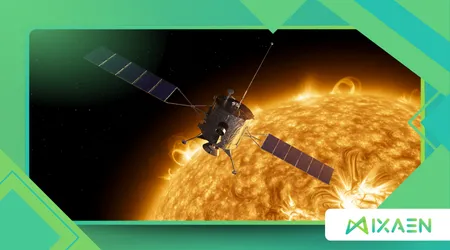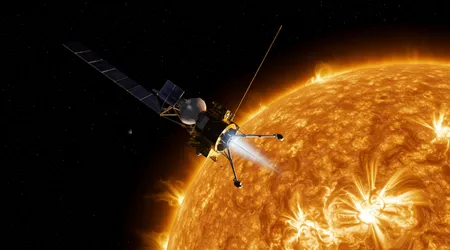The Parker Solar Probe: Flying Into the Heart of Our Star

The Parker Solar Probe dares to venture where no spacecraft has gone before, diving into the Sun’s scorching corona to unlock its secrets.
Anúncios
Launched by NASA in 2018, this audacious mission is rewriting our understanding of solar phenomena, revealing the Sun’s dynamic nature and its profound impact on Earth.
Why does the Sun’s outer atmosphere burn millions of degrees hotter than its surface? How does it hurl particles across the solar system at breakneck speeds?
These questions, once distant mysteries, are now within reach thanks to this trailblazing probe. With its record-breaking flybys, The Parker Solar Probe is not just a feat of engineering but a beacon of human curiosity, illuminating the cosmos one daring orbit at a time.
This journey into the Sun’s heart is more than a scientific endeavor; it’s a testament to our relentless pursuit of knowledge.
By studying the Sun up close, The Parker Solar Probe tackles questions that have puzzled scientists for decades, offering insights into solar wind, coronal heating, and space weather.
This blog post explores the mission’s groundbreaking discoveries, its ingenious design, and its implications for life on Earth.
From surviving blistering temperatures to capturing unprecedented data, the probe’s story is one of resilience and revelation. Let’s dive into the fiery saga of The Parker Solar Probe and its quest to touch the Sun.
A Mission Born of Vision and Valor
Imagine a spacecraft plunging toward a star, defying heat that could melt steel in seconds. The Parker Solar Probe does exactly that, skimming just 3.8 million miles from the Sun’s surface.
Named after Eugene Parker, who theorized the solar wind in 1958, the mission honors his legacy by exploring the Sun’s corona.
Launched on August 12, 2018, it uses Venus’s gravity to slingshot closer to the Sun, shrinking its orbit with each pass. By 2024, it achieved a record-breaking speed of 430,000 mph, making it the fastest human-made object ever.
++ How NASA Is Studying the Sun Without Getting Burned
The probe’s mission is to unravel three core mysteries: why the corona is hotter than the Sun’s surface, how solar wind accelerates, and what drives energetic particles.
These aren’t just academic puzzles they affect satellites, astronauts, and Earth’s power grids. In December 2021, The Parker Solar Probe became the first spacecraft to enter the corona, sampling particles and magnetic fields.
This milestone, akin to stepping into a cosmic furnace, provided data that reshaped solar science.
Consider a chef trying to understand a flame by standing far away distant observations only reveal so much.
The Parker Solar Probe gets close, enduring 2,500°F while its instruments stay cool. Its findings, like discovering switchbacks in the solar wind, show a chaotic, dynamic Sun. These insights help predict space weather, protecting technology we rely on daily.

Engineering a Star-Toucher
How do you build a spacecraft to survive the Sun’s wrath? The answer lies in a 4.5-inch-thick carbon-composite heat shield, a marvel of engineering.
This shield withstands temperatures nearing 2,500°F, keeping instruments at room temperature.
The probe’s design, crafted by Johns Hopkins Applied Physics Laboratory, includes four instrument suites to study plasma, magnetic fields, and energetic particles.
Each component is a testament to precision, built to endure radiation 500 times stronger than Earth’s.
The probe’s autonomy is equally impressive. During perihelion, when it’s closest to the Sun, communication with Earth ceases.
Also read: Could a Solar Superstorm Take Down the Internet?
It operates solo, collecting data and transmitting later via the Deep Space Network. On December 27, 2024, after a record flyby, it sent an “I’m OK!” signal, confirming its resilience.
This autonomy is like a mountaineer navigating a blizzard without a guide relying on preparation and instinct.
Cooling systems are critical. Solar panels retract during close approaches to avoid melting, and a water-based cooling system protects electronics.
These innovations ensure the probe thrives in an environment where survival seems impossible. By June 2025, it completed its 24th orbit, each one pushing the boundaries of engineering and discovery.
Discoveries That Redefine the Sun
The Sun isn’t a static fireball it’s a turbulent engine of plasma and magnetic fields. The Parker Solar Probe has revealed its complexity, capturing data no telescope could. In 2021, it confirmed the corona’s magnetic dominance, where solar wind shifts from subsonic to supersonic.
This finding, detailed in a 2023 Space Science Reviews article, showed switchbacks kinks in magnetic fields last from seconds to hours, hinting at their coronal origins.
These switchbacks are like sudden gusts in a storm, reshaping our view of solar wind dynamics. The probe also found microscopic dust particles near the Sun, previously undetected, offering clues about the solar system’s early days.
By studying these, scientists better understand how solar activity drives space weather, which can disrupt GPS and power grids.
Read more: How Solar Energy Powers the Heliosphere: Unraveling the Sun’s Cosmic Influence
Data from the probe’s SWEAP instruments, released publicly in November 2024, showed the corona’s temperature reaches millions of degrees, far hotter than the surface.
This paradox drives ongoing research. Each orbit brings new revelations, like a detective piecing together a cosmic puzzle, transforming our grasp of the Sun’s influence.
| Orbit Number | Date | Distance from Sun (miles) | Speed (mph) |
|---|---|---|---|
| 1 | Jan 19, 2019 | 15,000,000 | 153,454 |
| 17 | Sep 27, 2023 | 4,510,000 | 394,000 |
| 24 | Jun 19, 2025 | 3,800,000 | 430,000 |
Table: Key perihelia of The Parker Solar Probe, showcasing its shrinking orbit and increasing speed. Data sourced from NASA’s official timeline.
Impacts on Earth and Beyond
Why should we care about a probe circling the Sun? Because its findings protect our tech-driven world. Space weather, driven by solar flares and coronal mass ejections, can cripple satellites and power grids.
The probe’s data helps forecast these events, safeguarding billions in infrastructure. In 2024, it observed solar wind rotation stronger than expected, aiding predictions of auroras and disruptions.
Beyond Earth, the mission informs future space exploration. Understanding energetic particles is crucial for astronaut safety on Moon or Mars missions.
The probe’s insights into coronal heating could inspire new energy technologies, mirroring how solar fusion powers the Sun. It’s like learning from nature’s ultimate reactor to solve earthly problems.
The mission also sparks curiosity. Over 1.1 million people sent their names on a memory card aboard the probe, a symbolic journey to the Sun.
This engagement shows science’s power to unite us, pushing boundaries while grounding us in shared wonder.
The Future of Solar Exploration

What lies ahead for The Parker Solar Probe? Its mission extends into 2026, with more flybys planned to probe deeper into the corona.
Each orbit refines our models of solar activity, potentially unlocking secrets of stellar evolution. The probe’s data, shared globally via the SWEAP website, fuels research for decades.
Collaboration with ESA’s Solar Orbiter enhances its impact. While The Parker Solar Probe samples the corona directly, Solar Orbiter provides distant images, creating a fuller picture.
This teamwork is like a painter and a photographer capturing the same scene from different angles each perspective enriches the other.
The mission’s legacy will outlive its orbits. By revealing the Sun’s inner workings, it paves the way for future probes, perhaps to other stars.
Its data could inspire breakthroughs in plasma physics, energy, and space travel, proving that daring exploration yields timeless rewards.
Conclusion: A Beacon of Human Ambition
The Parker Solar Probe is more than a spacecraft it’s a symbol of human ingenuity and courage. By venturing into the Sun’s corona, it has illuminated mysteries that shape our world and beyond.
From switchbacks to space weather forecasts, its discoveries ripple through science and society.
As it continues its fiery dance, the probe reminds us: no frontier is too daunting when curiosity leads the way. What will we learn next as we chase the Sun’s secrets?
Frequently Asked Questions
How does The Parker Solar Probe survive the Sun’s heat?
Its 4.5-inch carbon-composite heat shield withstands 2,500°F, protecting instruments with advanced cooling systems, keeping them near room temperature.
What are switchbacks, and why do they matter?
Switchbacks are sudden reversals in the Sun’s magnetic field, discovered by the probe. They reveal how solar wind accelerates, impacting space weather predictions.
